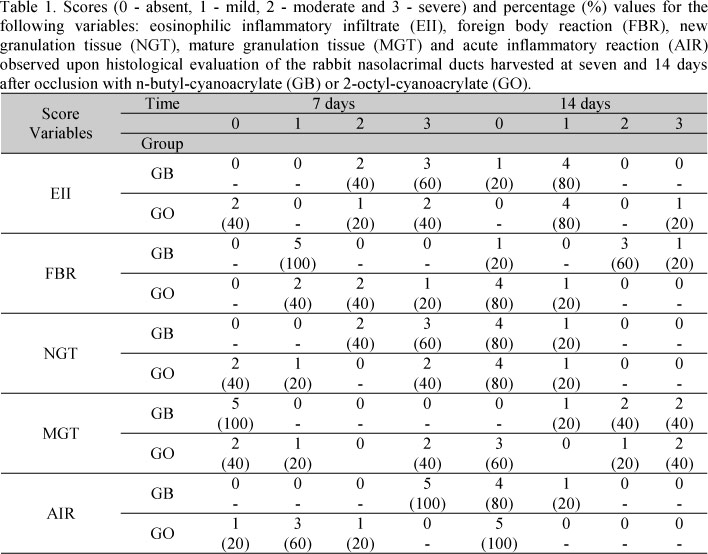The objective of this study was to evaluate the clinical and histological effects of occluding the nasolacrimal ducts and points of rabbits. For this study, 20 adult New Zealand rabbits, both males and females, weighing 3.2±0.4kg were allocated into two groups for n-butyl-cyanoacrylate occlusion (GB, n=10) or 2-octyl-cyanoacrylate occlusion (GO, n=10). The contralateral eyes served as the controls. The persistence of tears was evaluated daily using the Schirmer I test. Discomfort, eye discharge, epiphora, and conjunctival hyperemia were assessed prior to the procedure (T0) and during the 14 subsequent days (T1-T14). On days seven and 14, five animals from each group were euthanized, and their nasolacrimal ducts were collected, processed and analyzed by histology. In the GB group, the Schirmer test values differed from that at T0 at all of the subsequent time points, whereas there was no difference in the values observed from the GO group. Compared with the corresponding controls, the GO and GB groups differed significantly at almost all of the time points. When comparing the treatment groups, differences were found at T6, T7, T9, T10, T11, T12 and T14, with higher Schirmer values in the GB group. Epiphora was observed in the GB group from T1 to T8 and in the GO group from T1 to T6. Within seven days post-occlusion, histology revealed a moderate foreign body reaction, with marked necrosis and sloughing of the canalicular epithelium, in the GO group, which was absent at day 14. In the GB group, a marked inflammatory reaction and a mild foreign body reaction were found at day seven, and the foreign body reaction was prevalent at day 14. This study demonstrated that both adhesives were effective in obstructing the nasolacrimal ducts and points of rabbits and that their application and handling are easy and free of complications. However, both adhesives promoted inflammatory and foreign body reactions that evolved to repair and regeneration at day 14 of evaluation.
dry eye; keratoconjunctivitis sicca; Schirmer test; tear




